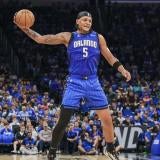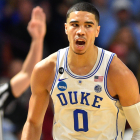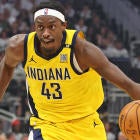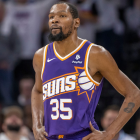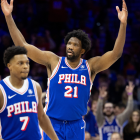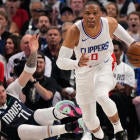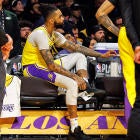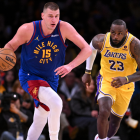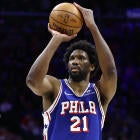Boston won the NBA Draft Lottery on Tuesday and with its No. 1 pick, I have the Celtics taking Duke's Jayson Tatum in this mock draft.
I know what you're thinking. Why not slot Markelle Fultz or Lonzo Ball, which conventional wisdom would have going No. 1, here?
Well, the Celtics have a shorter but more experienced version of Fultz already in Isaiah Thomas, an incredible shot-maker whose defense leaves plenty to be desired. And I'm not sure if Brad Stevens is the type of coach who wants to deal with LaVar Ball's distractions when he's trying to make an NBA Finals as soon as possible.
Tatum is the perfect fit for Boston. He's a mature, high-character guy who gives the Celtics a guy who can score on all three levels. Tatum may not have the highest ceiling in this draft, but I believe he's got the highest floor. It's a win-now pick for the rare title contender that has a top pick in the draft.
| 1 | |
| Jayson Tatum, SF, Duke: One NBA general manager compared Tatum to Ron Artest (when Artest was good), and to me, that's the type of piece that could immediately vault Boston into a championship contender. Though it wouldn't surprise me if the Celtics swing some sort of trade with this pick to pick up an established NBA star (Jimmy Butler?). | |
| 2 | |
| Lonzo Ball, PG, UCLA: With Ball being teammates with D'Angelo Russell and Jordan Clarkson, the Lakers will have one of the top young backcourts in the NBA. Lonzo Ball has the tools to become the next superstar point guard in this league. Yes, he has a funky shooting form – but scouts have told me that since the results are just fine (41.2 percent from 3-point range) so there's no reason to mess with it. | |
| 3 | |
| Markelle Fultz, PG, Washington: Fultz is one of the most dynamic offensive point guards to come out of college in a while. The prospect of Fultz and Ben Simmons trading off point guard duties is scintillating. I have my concerns about Fultz – namely, his defensive focus – but it's difficult to differentiate between what had to do with him and what had to do with his dysfunctional nine-win college team. But there's no doubting his highlight-reel talent, especially on offense. | |
| 4 | |
| De'Aaron Fox, PG, Kentucky: OK, I'll say it: I think De'Aaron Fox will be a better all-around point guard than Markelle Fultz, and could end up as the best player in this draft – if he is able to add a competent 3-point shot to his arsenal. (That's something an Eastern Conference scout told me as well.) He's the speediest player in this draft. He measured well at the combine. He's the best two-way point guard in this stacked point guard draft. He can create. And pairing Fox and Devin Booker could make the Suns the most exciting backcourt in the league. | |
| 5 | |
| Josh Jackson, SF, Kansas: If Jackson can become a small-ball power forward in the NBA – and that's by no means a guarantee – this could be a perfect fit for Sacramento's young and talented roster. Jackson provides all that and more, plus a fiery attitude that this floundering franchise could use. | |
| 6 | |
| Lauri Markkanen, PF, Arizona: The Magic need everything. So they should take the best talent available. It's hard to imagine there will be a better talent available here than Markannen. He's one of the top three-point-shooting seven-footers in college basketball history. The Finnish freshman was one of the most efficient scorers in all of college basketball last season. | |
| 7 | |
| Malik Monk, SG, Kentucky: A streaky shooter who, when he's on, is impossible to stop. While his unimpressive size may become an issue in the NBA, he makes up for it with some of the most explosive athleticism in this draft. The Wolves already have a crowded backcourt – but they could use a knockdown shooter like Monk. | |
| 8 | |
| Dennis Smith Jr., PG, NC State: Smith is an unfinished, inconsistent product – his sole college season swung wildly from remarkable to disastrous depending on the game – but when he's good, he's good, as his career-high 32-point outburst to beat Duke on the road will attest. The Knicks didn't win the lottery, but Smith falling this low could give the Knicks a helluva consolation prize in a stacked point guard draft. | |
| 9 | |
| Frank Ntilikina, PG, France: Watch his game tape and you see a remarkable perimeter defender and great game manager. Ntilikina reminds me a little bit of Delon Wright. I'm not sure he'll become a star, but he could become a very solid two-way player for a playoff team. | |
| 10 | |
| Jonathan Isaac, SF, Florida State: You can make an argument (as one NBA scout did to me) that Isaac has the highest upside in this entire draft. The scout said Isaac, if he adds muscle, could someday be spoken of in the same "physically off the chart" tier as LeBron or Paul George. This team has to bet on the future. The Kings are rife with talented young projects. Isaac would be one more. | |
| 11 | |
| Zach Collins, PF, Gonzaga: Collins was a big-time freshman contributor on Gonzaga's national runner-up squad, so he's already been able to show off his full toolbox of mature offensive skills – and excellent defensive instincts – on the national stage. The idea of Collins being on the floor with Frank Kaminsky is tantalizing – two 7-footers who can spread the floor and open things up for Kemba Walker. | |
| 12 | |
| Luke Kennard, SG, Duke: I think Kennard is the most underrated player in this draft, which is why he's higher here than you'll see anywhere. It may seem like a stretch for Kennard here – that the Pistons could get a higher upside player at this slot – but Kennard feels like such a solid offensive player. He could develop into a lefty J.J. Redick in time, which is one thing the Pistons, a mediocre three-point shooting team, need. | |
| 13 | |
| Justin Jackson, SF, North Carolina: You don't hear these stories much anymore: A highly-regarded five-star recruit who underwhelms at first, stays in college for three seasons and develops into a lottery pick. Jackson is a reminder that college players can develop at different rates, and that shouldn't be considered a bad thing. A 3-point shot that had been inconsistent for his first two seasons stabilized his junior year, and Jackson became the versatile and athletic go-to guy for a national championship team. | |
| 14 | |
| John Collins, PF, Wake Forest: With Chris Bosh all but gone, Collins is the best option here: A high-ceiling frontcourt player who fills an immediate need. Collins was one of the most efficient scorers in college basketball last season; if he can develop more range on his shot, he'll be a steal at this point in the draft. | |
| 15 | |
| OG Anunoby, SF, Indiana: Is there a Draymond Green in this draft? It could be Anunoby, whose in-between size used to be considered a negative but could now be considered a perfect fit for today's NBA. Anunoby can guard multiple positions at a high level. He's a great athlete. And he plays much bigger than his height (6-7 with a 7-2.5 wingspan). This is past the point of the draft where there are sure things. Anunoby may be risky, as his offensive skills leave plenty to be desired, but it's a risk worth taking. | |
| 16 | |
| Ike Anigbogu, C, UCLA: I'm higher than Anigbogu than many. He's the type of player that coaches and general managers can look at and paint their own canvas on. For a team like the Bulls, an enormous paint presence like Anigbogu is much needed. The offensive end is very much a work in progress. | |
| 17 | |
| Justin Patton, C, Creighton: There's been plenty of attention paid to this as a point guard-heavy draft. But it's also one of the deepest drafts for talented young big men that we've seen in a long time. Although he needs to put on some muscle so he can hang with NBA bigs, Patton is a superb athlete for a 7-footer, and showed impressive offensive versatility at Creighton as well. He may take some time to fill his potential, but the potential is certainly there. | |
| 18 | |
| Jarrett Allen, C, Texas: The size is there, clearly, and so is the potential. But the massive struggles from the free-throw line (56 percent in college) plus the lack of offensive tools give me pause whether he'll ever develop into anything more than an intimidating, explosive low-post presence. But getting this sort of potential at this point in the draft makes Allen worth the risk. | |
| 19 | |
| Hamidou Diallo, SG, Kentucky: The Thon Maker of this draft, in the sense that Diallo has not played in a collegiate game (his time at Kentucky was as a redshirt freshman for the second semester) yet has an outside shot at being picked in the lottery. If he were to stay for a full season at Kentucky, I bet he'd be a surefire top-10 pick, but you can't blame Diallo for taking the money now instead of taking on the risk of playing for free for another year. The phrase "physical freak" was created for Diallo. He had the second-highest vertical leap ever recorded at the NBA combine at 44.5 inches, and his other measurable were nearly as impressive. You thinking what I'm thinking here? Yeah – he could become a Zach Lavine-type of NBA player. If, that is, he can improve his deficiencies, namely shooting. | |
| 20 | |
| Harry Giles, PF, Duke: When you have three first-round picks, you can take a home-run swing. There's no bigger home-run swing in this draft than Giles. He could perform in the NBA like a top-five pick – that's what he was considered to be before he tore an ACL for the second time his senior year in high school – or he could never see a minute of NBA play because of injuries. If it's still possible for Giles to fulfill the potential scouts saw in him two years ago, he could become a Chris Webber Lite, or Kevin Garnett Light. Like Skal Labissiere before him, Giles saw his stock plummet as he struggled during his lone college season. And like Labissiere, the charming and smiling Giles is easy to root for. | |
| 21 | |
| Alec Peters, PF, Valparaiso The Thunder had the worst 3-point percentage in the NBA last season. Enter Peters, one of college basketball's top shooters. No, he may not have NBA athleticism, but for a team that needs to make shots, Peters and his remarkable 60.4 percent true shooting percentage fits. Oklahoma City is a team that needs to win now; taking a college senior like Peters is more wise than taking some sort of project. | |
| 22 | |
| Terrance Ferguson, SG, Australia: The Nets have needs across the board and no lottery picks to fill them. But Ferguson has the size and elite shooting stroke of a player about whom we could someday say, "I can't believe he wasn't a lottery pick!" The Nets are also one of NBA's worst 3-point shooting teams. Ferguson's post-high school season in an Australian professional league helped him learn how to play against grown men, which will only help with his NBA learning curve. | |
| 23 | |
| TJ Leaf, PF, UCLA: Is he Kevin Love? No – but the comparison, of a tall, white power forward from UCLA who can rebound and make threes, is an easy one to make. He was a vital part of the most up-tempo NBA-like team in college basketball last season. I don't know what the uncertain future of the Raptors will hold, but I know that a player like Leaf can find a fit on any NBA team. | |
| 24 | |
| Caleb Swanigan, PF, Purdue: Short vent session here: I've heard enough about how Swanigan's body, size and athleticism aren't NBA-ready. It's BS. This is a guy who is one of the hardest workers I've been around in college basketball, both off the court and on. He understands what his primary role will be in the NBA: As a rebounder who outworks his opponents. No, he doesn't fit into the nice pretty box of what we think of as NBA power forwards. But he's such a high-character guy with so much tangible and intangible basketball talent that he'll absolutely become a positive presence on a winning basketball team. | |
| 25 | |
| Jordan Bell, PF, Oregon Forget, if you can, Bell's bonehead box-outs in Oregon's national semifinal game. Instead, remember that Bell's play throughout the tournament was the reason Oregon made it that far – especially after fellow big man Chris Boucher's injury. All tournament, he was all over the court on defense, culminating with the eight-block performance against Kansas that sent Oregon to the Final Four. He had double-digit rebounds his final seven collegiate games. Bell is a bouncy and ambitious defender who is developing as an offensive player. His great combine ought to vault Bell into the first round. | |
| 26 | |
| Ivan Rabb, PF, California: Rabb's decision to return for a sophomore year did not pay off in terms of draft stock, as he went from likely mid-lottery pick to far lower. While Rabb likes to compare himself to Chris Bosh, that's just self-hype. He's got a long way to go before even sniffing that level. But he's certainly worth a flier at this point in the draft as a project who, with added strength and more refined offensive coaching, could develop into a nice post player. | |
| 27 | |
| Donovan Mitchell, SG, Louisville: A stellar combine saw Mitchell's stock rocket up mock drafts. An explosive athlete who scored at the level Mitchell did at Louisville – his sophomore season, Mitchell averaged 15.6 points, more than double his average from his freshman season – is always welcome in the NBA, even if he is undersized for his position. | |
| 28 | |
| Jonathan Jeanne, C, France Jeanne's countryman, Rudy Gobert, was an absurdly tall, long and thin lottery ticket when the Utah Jazz nabbed him on draft night in a trade with the Denver Nuggets, who'd picked him at No. 27. It took some time, but Gobert has developed into one of the NBA's premier shot-blockers. Who is to say Jeanne can't, in time, develop into something along those lines? The Lakers have some of the worst rim protection in the league. | |
| 29 | |
| Josh Hart, SG, Villanova: Hart could be the Malcolm Brogdon of this draft: A guy who developed into a better and better player each of his four years in college, who is full of intangibles, and whose main attribute on the basketball court is simply that he's a winner. Does he have the athletic attributes of a lottery pick? Certainly not. But is he the type of high-IQ, hard-working consistent basketball player who could find his dream fit in San Antonio? Absolutely. Plus he's a great shooter, and nearly as solid of a wing defender as Brogdon is – one of the best perimeter defenders in this entire draft. | |
| 30 | |
| Bam Adebayo, C, Kentucky Check this dude's birth certificate, because there's no way a 19-year-old can be as cut as Adebayo is. He's like a 6-10 linebacker out there. While Adebayo may never be a creative offensive force, he can make a difference on both ends of the court based on sheer size, athleticism and motor. | |


































